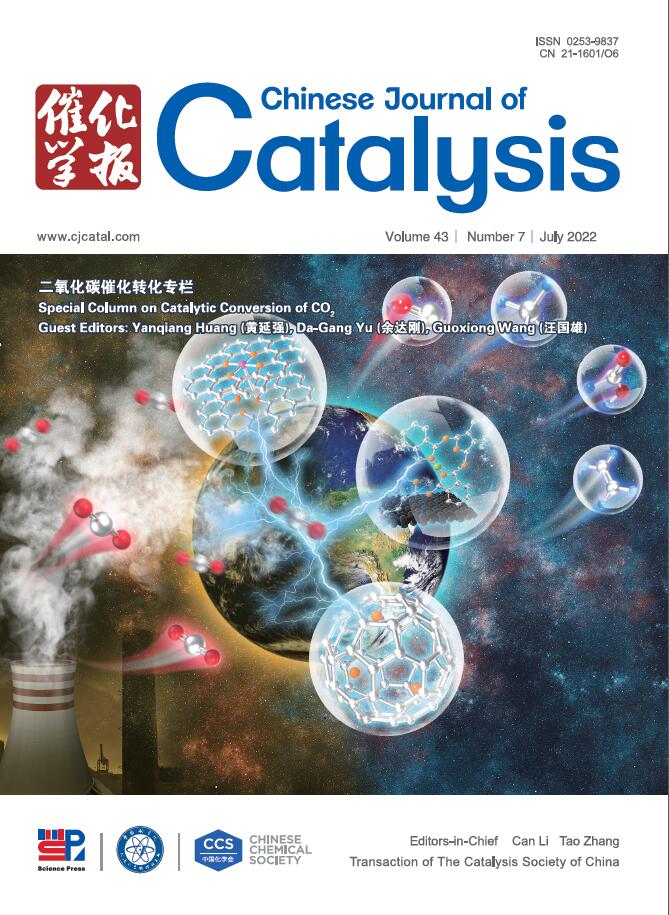乙醇/乙醛催化转化为1,3-丁二烯的双分子协同吸附机理研究
IF 15.7
1区 化学
Q1 CHEMISTRY, APPLIED
引用次数: 0
摘要
生物基乙醇催化合成1,3-丁二烯(1,3- bd)提供了一种替代石油的可持续方法。然而,1,3- bd的内在活性位点及其形成机制尚未完全阐明。通过将系统表征结果与催化性能相关联,确定了Zr/MFI-BM催化剂上Zr(OH)(OSi)3基团是催化乙醇-乙醛转化为1,3- bd的活性位点。结合控制实验和理论计算,提出乙醇和乙醛以双分子模式协同吸附在Zr(OH)(OSi)3上,这有助于乙醛缩合,加速关键的Meerwein-Ponndorf-Verley-Oppenauer还原,从而促进1,3- bd的形成。这些发现将激发对新型金属-沸石组合的探索,通过生物质衍生乙醇等高效生产增值的1,3- bd。本文章由计算机程序翻译,如有差异,请以英文原文为准。
Identifying a bi-molecular synergetic adsorption mechanism for catalytic transformation of ethanol/acetaldehyde into 1,3-butadiene
The catalytic synthesis of 1,3-butadiene (1,3-BD) from bio-based ethanol offers an alternative and sustainable process beyond petroleum. However, the intrinsic active sites and corresponding mechanism of 1,3-BD formation have not been fully elucidated yet. By correlating systematic characterization results with catalytic performance, the open Zr species, i.e., Zr(OH)(OSi)3 moieties, were identified as the active site over the Zr/MFI-BM catalysts for the catalytic transformation of ethanol-acetaldehyde into 1,3-BD. In conjunction with controlled experiments and theory calculations, ethanol and acetaldehyde are proposed to synergistically co-adsorb on the Zr(OH)(OSi)3 species in a bi-molecular mode, which assists the acetaldehyde condensation and accelerates the critical Meerwein-Ponndorf-Verley-Oppenauer reduction, and accordingly promotes 1,3-BD formation. These findings will stimulate the search towards new metal-zeolite combinations for efficient production of value-added 1,3-BD via biomass-derived ethanol and beyond.
求助全文
通过发布文献求助,成功后即可免费获取论文全文。
去求助
来源期刊

Chinese Journal of Catalysis
工程技术-工程:化工
CiteScore
25.80
自引率
10.30%
发文量
235
审稿时长
1.2 months
期刊介绍:
The journal covers a broad scope, encompassing new trends in catalysis for applications in energy production, environmental protection, and the preparation of materials, petroleum chemicals, and fine chemicals. It explores the scientific foundation for preparing and activating catalysts of commercial interest, emphasizing representative models.The focus includes spectroscopic methods for structural characterization, especially in situ techniques, as well as new theoretical methods with practical impact in catalysis and catalytic reactions.The journal delves into the relationship between homogeneous and heterogeneous catalysis and includes theoretical studies on the structure and reactivity of catalysts.Additionally, contributions on photocatalysis, biocatalysis, surface science, and catalysis-related chemical kinetics are welcomed.
 求助内容:
求助内容: 应助结果提醒方式:
应助结果提醒方式:


